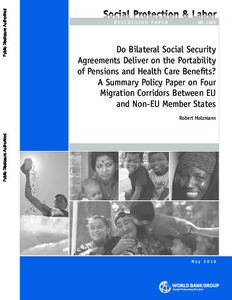Do bilateral social security agreements deliver on the portability of pensions and health care benefits? : A summary policy paper on four migration corridors between EU and Non-EU member states
"This policy paper summarizes four corridor studies on bilateral social security agreements (BSSAs) between four European Union (EU) member and two non-member states, draws conclusions on their results, and offers recommendations. BSSAs between migrant-sending and migrant-receiving countries ar...
| Main Author: | |
|---|---|
| Institution: | ETUI-European Trade Union Institute |
| Format: | TEXT |
| Language: | English |
| Published: |
Washington, DC
2016
World Bank |
| Subjects: | |
| Online Access: | https://www.labourline.org/KENTIKA-949912476719-Do-bilateral-social-security-a.htm |
| Summary: | "This policy paper summarizes four corridor studies on bilateral social security agreements (BSSAs) between four European Union (EU) member and two non-member states, draws conclusions on their results, and offers recommendations. BSSAs between migrant-sending and migrant-receiving countries are seen as the most important instrument to establish portability of social security benefits for internationally mobile workers. Yet, only about 23 percent of international migrants profit from BSSAs and their functioning has been little analyzed and even less assessed. The four corridors studied (Austria-Turkey, Germany-Turkey, Belgium-Morocco, and France-Morocco) were selected to allow for comparison of both similarities and differences in experiences. The evaluation of these corridors’ BSSAs was undertaken against a methodological framework and three selected criteria: fairness for individuals, fiscal fairness for countries, and bureaucratic effectiveness for countries and migrant workers. The results suggest that the investigated BSSAs work and overall deliver reasonably well on individual fairness. The results on fiscal fairness are clouded by conceptual and empirical gaps. Bureaucratic effectiveness would profit from information and communication technology-based exchanges on both corridors once available." |
|---|---|
| Physical Description: | 62 p. Digital |

